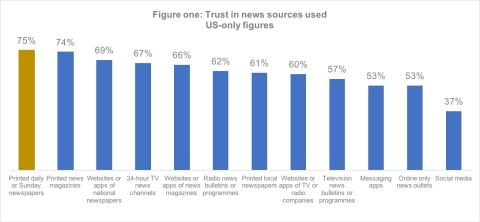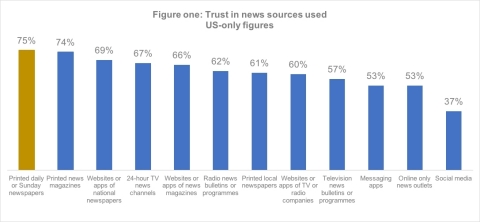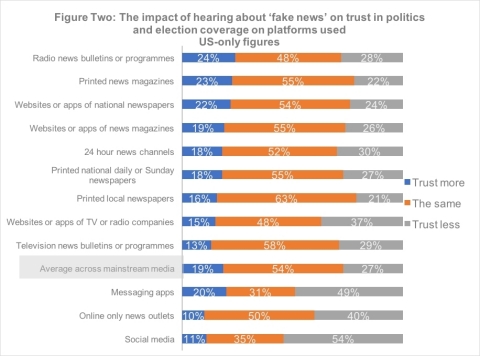LONDON--(BUSINESS WIRE)--Kantar today releases the results of its global ‘Trust in News’ study. The report, which surveyed 8,000 individuals across Brazil, France, the United Kingdom and the United States of America about their attitudes to news coverage of politics and elections, finds:
1. The efforts to brand ‘mainstream news media’ as ‘fake news’ have largely failed. The reputation of traditional print and broadcast media outlets has proven more resilient than social media platforms and online only news outlets, primarily as a result of the depth of coverage being delivered.
2. Audiences are becoming more widely informed and sophisticated in their engagement with, and evaluation of, news content.
3. The public retain a belief that journalism is key to the health of democracy – but have become more skeptical. Specifically, in both in Brazil and USA, where a significant percentage of the population believe ‘fake news’ impacted the outcome of their most recent elections.
Who do we trust?
The reputational fallout of the ‘fake news’ phenomenon has been predominantly borne by social media and messaging platforms, and ‘online only’ news channels. Print magazines, at 72%, are the most trusted news source, closely followed by the other traditional outlets of print newspapers and TV and radio news. Only one in three recognize social media sites and messaging apps as a trusted news source. ‘Online only’ news outlets are trusted by half of the population, significantly less than their print and broadcast brethren. Interestingly, the online presence of print and broadcast media are trusted slightly less than the originating titles and channels.
Social media and messaging platforms have sustained significant reputational damage as a source of trusted news. News coverage of politics and elections on social media platforms (among which Facebook is dominant with 84% usage in the preceding week) and messaging apps (of which Whatsapp is the most used) is ‘trusted less’ by almost sixty percent of news audiences (58% & 57% respectively) because of the ‘fake news’ phenomenon. ‘Online only’ news outlets also sustained significant reputational damage in this respect: ‘trusted less’ by 41% of news audiences.
Print titles have proved more resilient, experiencing a smaller loss of trust, with print magazines and newspapers both ‘trusted less’ by 23% of audiences. However, both categories also experienced similar increases in trust in their coverage (23% and 17% respectively). Print media nets out with more than three quarters of news audiences trusting them ‘the same’ or ‘more than’ before the ‘fake news’ phenomenon. 24-hour news channels also retain a strong position as a trusted source with 78% of news audiences trusting them ‘the same’ or ‘more than’ before the ‘fake news’ narrative.
Across all four surveyed countries, 46% of news audiences believe ‘fake news’ had an influence on the outcome of their most recent election. This was most pronounced in Brazil – where 69% believed fake news had an impact, and the USA where 47% believe there was an influence. There is though some recognition that companies like Facebook and Google are taking steps to tackle ‘fake news’. (13% of UK news audiences claiming to have seen efforts vs a third of Brazilians, 16% in France and 22% in the US).
News consumption habits are evolving.
The news-reading public are becoming a more widely informed audience. 40% of news audiences have increased the number of news sources they use compared to 12 months prior. ‘All online’ has overtaken television as the primary source of news (figure 3). With under 35 year olds, social media – despite its reputational issues –almost matches television as a source of news (65% Vs 69%).
The news audience is additionally becoming a more thoughtful audience. Contrary to ‘news filter bubble’ or ‘echo chamber’ narratives, we find 40% of social media users explore alternate views to their own and almost two thirds worry that ‘personalization’ will create a ‘news filter bubble’. More than three quarters of news consumers claim to have independently fact-checked a story, while 70% have reconsidered sharing an article – worried that it might be fake news. On the flip side, almost one in five admit to sharing a story after reading only the headline.
The Kantar ‘Trust in News’ survey conducted representative sample surveys of 2,000 individuals each in Brazil, France, the United Kingdom and the United States of America. A more complete summary of the survey can be found on Kantar Insight pages, along with access to the full report.
Quotes:
Eric Salama, CEO, Kantar
“Traditional news media have largely defended itself against the “fake news” accusations and continue to enjoy high levels of trust among news audiences. The challenge now is for those companies to monetize that loyalty and we've identified some routes for them to explore. Traditional news media need to have the confidence to invest in their brands, while devising flexible subscription models for younger generations of consumers who have grown comfortable with subscription models. Trust in News will prove a rich source of insight for all news providers trying to navigate this societally-important and fast-changing market.”
Sir Martin Sorrell, CEO, WPP
“I am pleased to see Trust in News confirm that brand recognition is still a key driver for direct engagement between news brands and consumers. We know the major social media companies have started to address the ‘fake news’ problem. In quantifying the extent to which ‘fake news’ has damaged the reputations of social media brands as sources of news, this study reinforces how important that work will be moving forward.”
---End---
Note to Editors - US DATA POINTS
Social Media still has more believers than non-believers:
- 37% of Americans believe social media outlets can provide trustworthy news, which is far less than the 70%* that feel that printed news outlets, including magazines, provide them with trustworthy news.
- Older respondents (over 55 years old) were more likely to have an “untrustworthy” viewpoint vs younger.
*this is the average between National newspapers (75% positive); Local newspapers (61% positive); and news magazines (74% positive)
Political ideology affects how consumers gauge social media’s trustworthiness
- Nearly half (47%) of right-leaning consumers have a positive outlook on social media’s ability to provide them with news they can trust, while only 22% of left-leaning respondents shared that same view.
- On the flipside, left-leaning respondents were more likely to describe news on social media as untrustworthy (37%) compared to right-leaning ones (23%).
Newspapers are proving far more resilient to “fake news” epidemic than social media
- More than half (59%)** of Americans say hearing about “fake news” hasn’t affected their level of trust in newspapers, and 17% said it’s actually increased their level of trust.
- However, 24% admit that “fake news” has decreased their level of trust in newspapers.
- When it comes to social media, 54% of Americans say that “fake news” has eroded their trust in those sources.
** Average between national and local newspapers
What is “fake news”?
- Overall, more than 60% of Americans believe the term “fake news” is defined as a story that is factually incorrect, either by mistake or on purpose.
- 72% of right-leaning Americans believe that “fake news” means a story that is deliberately fabricated by a mainstream news outlet.
- When it comes to moderate or left-leaning respondents, a little more than half would use that definition.
- Only 37% believe that “fake news” is something put out by someone masquerading as a news outlet.
How consumptions habits have changed
Americans are varied in how they get their news, though social media is becoming a primary news source
- 38% of Americans said they get their news by using social media.
- The next-most cited was a tie (36%) between keyword searches or directly accessing news websites and apps.
- Despite holding an unfavorable view of social media’s trustworthiness, left-leaning respondents were more likely to use it as their main news source (44%) compared to right-leaning (35%).
- Showing its place as the dominant social media platform, Facebook was overwhelmingly cited as the top news source on social, with 85% saying they use the platform as a news source.
Life beyond the Advertising
Americans want news to remain free to access, believing that media outlets still get enough ad revenue to support themselves:
- Nearly ¾ of Americans (72%) say they haven’t paid for any kind of news content online in the past year.
- Compared to the global sample, Americans are more likely to buy a newspaper, with 45% saying they’ve purchased one in the past week, compared to 40% of global respondents.
- More than half (56%) don’t see the point in paying for online news (via a subscription fee) because they can access everything they need for free.
- Just 8% feel it’s their duty to pay for unbiased and independent journalism.
- 21% feel that news organizations get enough money from online advertising to support themselves.





